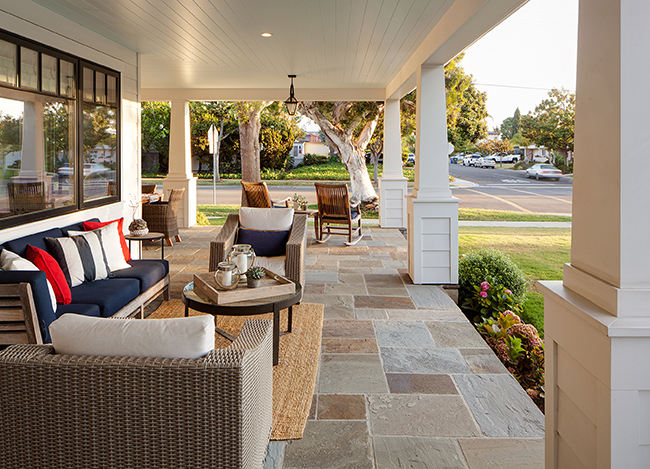Can Coronado retain its small town charm in an era of ever-increasing density?
It’s a fine line that architects and builders walk in Coronado as they strive to produce homes that meet their clients’ wants and needs, while trying to maintain the sense of history and charm that symbolizes the city.
And, as housing density grows, so do the number of cars vying for the finite amount of parking on city streets.
Leading the charge for updating the city’s zoning requirements is architect Dorothy Howard. Howard, who also serves on the city’s commercial design review committee, heads the RSIP3 (Residential Standards Improvement Program) committee. The city’s instructions to the committee, Howard said, were to “be more aggressive” in this third attempt in as many years to tighten zoning codes to restrict bulk and mass.
The biggest concern is when a single home (or two) that comfortably spanned two lots totaling 50 by 140 feet, is razed and in its place four “cloud condos” are erected. Cloud condos are in essence structures that do not touch but occupy the same dirt and air space. Often, they are built with tandem parking garages that end up being used for storage, with tenants opting to park on the street.
“That’s what these properties in the R3 zone are zoned for,” Howard said. She noted that the first zoning maps in Coronado took effect around 1973. Prior to that there was no zoning.
Zoning started in various states and communities about a century ago, although some cities, including Houston, still have no zoning. “You can build anything anywhere there,” Howard said.
In California, cities must set aside land for multi-family homes, Howard said. The mandate is to allow all socio- economic groups an opportunity to live in a community.
The RSIP3 committee’s recommendations will likely go to council vote following the November election. “RSIP3 didn’t change the maximum FAR (floor area ratio) but it will be harder to get there, with fewer things that you can get points for. We didn’t want to award points for items that don’t contribute to minimizing bulk and mass, such as installation of solar,” Howard said. “You can still get a point for keeping a mature tree in the front yard, but not for planting a tree. And we are recommending that anyone who submits their design to a voluntary design review committee would get four points.”
Another recommendation in the R3 zone, is that “where there are long skinny [tandem] garages, they will be required to have open stalls to encourage people to park there,” Howard said.
On small town village atmosphere
Is Coronado’s small town charm alive and well or has the bloom begun to wither?
“A lot of things feed into small village charm,” architect Christian Rice said. “Knowing your neighbors is a big part of it, having activities in your neighborhood. Walking your dog. And having a house that is ‘extroverted.’”
Rice said that it’s all about a sense of openness: windows and doors in the front of the house to give it “eyes to the street” and picket fences that can privatize a yard but are friendly and open.”
“Our zoning ordinances encourage a sense of neighborhood, with FAR’s bonus system, such as incorporating a front porch, to gain a point or two in allowable square footage,” Rice noted.
Architect Kevin Rugee said that despite the fact that many new houses are two stories, they can still fold well into a community’s fabric.
“Size is relative to what a family needs to function,” Rugee said. “But even large homes can turn out to be pretty nice.”
He referred to two historical homes, both small and large that his company recently completed: one at Eighth and J streets received a Coronado GEM (going the extra mile) nomination from the Coronado Historical Association and the other at Alameda and J won the GEM award this year.
Rugee believes that Coronado will always have a small town feel. “Coronado is an island and is its own city — and one of the best cities in the country the way it’s run.
“We lived in La Mesa and before that Del Cerro and there is nothing, nothing that goes on in those cities like what happens here,” he said. “It’s the people who are here and do a lot of good things for the community and are involved in the community. That’s what make this community great.”
Coronado eclectism
Howard likens the history of homebuilding in Coronado to peeling back the layers of a tree.
“As Coronado grew, its homes largely reflected the style that was popular at the time, starting with Queen Anne Victorians. Craftsman and Spanish bungalows came into vogue in the teens and up through the 1930s. Then the Palmers were built as postwar housing, kind of our version of Levittown, N.Y. Then came the Country Club homes that, along with the Palmers, were the closest thing Coronado ever had to tract housing. Those single-story Country Club homes were the height of residential style at the time — just look at a Better Homes & Garden magazine in 1955.”
Coronado doesn’t really have a style, Howard said, and that’s just the way she and other builders and architects like it. “We’re not Santa Barbara, and we’re not Disneyland’s main street, where everything looks like it came from the same distinct period,” she said. “We’re far more interesting.”
Christian Rice said many of his clients like to mesh two styles — perhaps Cape Cod and contemporary or Spanish and contemporary — into a home design.
Rice has also designed several contemporary condominium projects. One at the corner of Sixth and Orange (across from Spreckels Park) had zoning that would have allowed nine units. Instead, Rice’s client settled on four, with the “condos” joined only in the back taking on the appearance of contemporary single family homes, especially with individual siding and details. Rice is also designing a new home for his family of four, a two-story main house with a central courtyard of contemporary design.
“Lots of times people will confuse the word contemporary with modern,” Rice said. “Modern architecture refers to the period of the mid-1950s through the 1970s.”
Scale and proportion
Rugee said that he asks clients to bring him photos from magazines, or the popular websites Houzz and Pinterest to see what they like and don’t like.
“Part of being a good architect is being a good listener,” Rugee said. “It’s about considering the overall scope of the work and all the things a client wants and then honing that into the reality of what you can actually do.
“You sometimes have to double up on the uses of rooms, which leads to the popularity of an open great room that unites a dining room, kitchen and family/living room. Or it might mean a ‘flex’ room that can be a study or office and double as a guest room.
“You don’t want rooms to sit around and not be used,” Rugee advised. “That includes back and front patios. I will ask a client, ‘Do you do a lot of entertaining?’ The type of amenities that go into a back patio has to fit the proportion of the space. It might be a simple barbecue and place to sit and eat and enjoy a glass or wine.
“You always want a balance between the interior room sizes and the exterior so you’ll feel comfortable in the space.”
Less is sometimes more
While architects often design large homes, they are delighted when they come across the opportunity to build or remodel smaller spaces.
Rice points to a project he designed at Sixth and Country Club that’s received a lot of positive feedback from neighbors. “It’s a huge lot. The family with three young boys wanted a big backyard, but they didn’t want a big house, so we kept it single story with a wraparound porch. The house sits at the front of a cul-de-sac, so it fits right into the community lifestyle.”
A Hawaiian Plantation-style home that Rugee designed for a couple on Glorietta Boulevard is nearing completion. “This huge lot could have easily accommodated a much larger home,” Rugee said. “But our clients preferred to keep it at a single story; they wanted it to be almost like a little boutique hotel. So we maximized the indoor and outdoor living areas with both covered and uncovered patios, created a double-pitched roofline topped with a green metal roof. That and the smooth stucco finish and rich wood detailing create a wonderful Hawaiian ambience.”
Rugee and his wife, Gail, recently moved to Coronado, remodeling a circa 1950s home they have owned for 20 years. The 1,200-square-foot house that Rugee describes as “our little cracker box” now features a Mid-Century Modern exterior, designed by Gail, an interior designer.
It’s just the right size for the empty nesters and just a couple of blocks from Rugee’s office on Isabella.
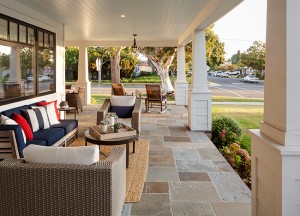
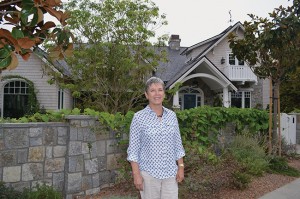
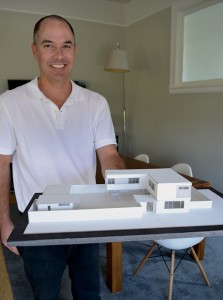
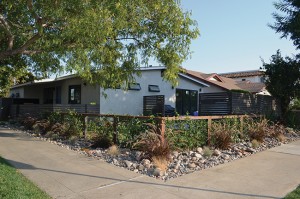

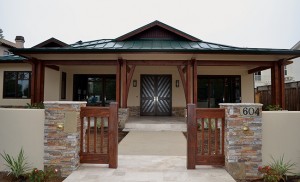
Profile: Bartocci Development
Joe Belmonte has an appreciation for Coronado’s historical homes that goes back to his years growing up on the island. He and his Coronado High School sweetheart, Sue, have been married for 44 years and live in a spacious Country Club home, an example of his firm’s design and build work.
Most recently, Belmonte and his firm, Bartocci Development, headquartered at 2535 Kettner Ave. in San Diego, completed a remodel of one of Coronado’s most iconic homes, a three-story residence at 611 A Ave. built in 1908 by noted San Diego architect William Hebbard. And while a priority was to keep the home’s Tudor exterior as intact as possible, the interior renovation was a different story.
“When you are working with a 100-plus-year-old home, you want to modernize the interior for how we live today,” Belmonte explained. “You want decent lighting and electrical that works well. These century-plus-old homes usually came with one center light in the bedroom ceiling and one or two outlets on the walls. Plus there was a lot of knob-and-tube electrical wiring, which most insurance companies won’t insure today.”
Therefore, from a practical standpoint, remodeling older homes often entails “going down to the studs,” Belmonte said. “Older homes didn’t have adequate and often no insulation. Sometimes we can ‘blow it in,’ but going down to the studs is usually the answer.”
For the A Avenue residence, Bartocci Development’s structural renovations included the installation of a steel beam and several headers to provide support and help open up rooms. “There had been some previous remodels, but they really didn’t match the style of the home,” Belmonte said. “Now it feels like a historical home.”
The 108-year-old floors were brought back to life. “These red oak floors had some aging and discoloration; that happens,” Belmonte said. “So, we sanded the old floors, installed new matching planks where we needed to and then replicated the stain and decorative accents.”
Belmonte noted that it was a general practice in days of yore to use finer oak flooring on the main floor, then pine on second and third floors, “especially when people would carpet over it,” he said. Bartocci Development ran the oak throughout and brought more light inside the house by turning a rear porch into a family room and raising the ceilings in the kitchen and dining room by a foot. “A foot doesn’t sound like much,” Belmonte noted, “But it made such a difference. We gained more height and light by raising the four headers in the kitchen and dining room and former porch by flush-cutting ceiling joists and cutting in the beams.”
The result is a big room with higher ceilings and the whole effect is bigger and brighter, he said.
The redesign removed a fireplace in the dining room and enlarged the fireplace in the living room. “It required a lot of work to bring the fireplace out 10 inches and enlarge the fire pit, but it made a huge difference,” Belmonte said.
Belmonte’s work extends to new construction as well. At the highest point on the island in the 300 block of F Avenue, he’s proudly finishing work on a home occupying one of Coronado’s most common lot configurations: 25 feet wide by 140 feet deep. “It’s an example of where you can live luxuriously and spaciously through design that is well-thought-out,” he said.
The new four-bedroom, four-and-a-half bath home features coffered and box-beam ceilings, two fireplaces (one in the master suite) and stone and brick accents on the exterior.
“The front patio and rear patio of the home will open with bi-fold doors and will visually enlarge the home,” Belmonte explained. It also includes a subterranean floor and rooftop deck with wet bar, which takes advantage of the 360-degree island and bay views. A carriage house over the alley garage embodies a mini-cottage feel with kitchenette, sleeping area, two dormer windows that create a great sitting area plus plenty of storage.
An outdoor kitchen and see-through free-standing fireplace provides a space for socializing between the main house and the carriage house.
Next, Belmonte is turning his attention to a project on F Avenue that includes a historic front house with Spanish style that he plans to replicate throughout the project and two new condominiums in the rear. And in the 300 block of J, he and architect Kevin Rugee are working on a historical renovation that has a “compound” feel: an existing home in the front will be renovated with historical designation pursued; a second two-story home was built in the rear with parking for two vehicles and another structure with a two-car garage and a cottage above is being proposed. “
Although it would have two different addresses, it would have a definite family feel. The owner, from Wisconsin, wants to retire here and wants to make sure his kids have a place to stay in Coronado,” Belmonte said. “The ultimate family dream!”
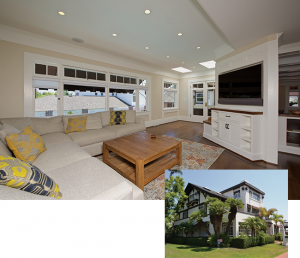
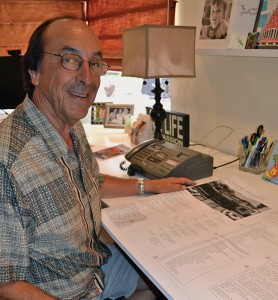
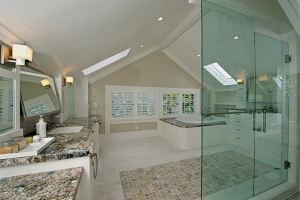
Profile: Coronado Construction Company
Bruce Woodruff and his son Will Woodruff have roots that run deep in Coronado. Bruce served as president of the Coronado Chamber of Commerce (1999-2000) and Will is a graduate of Coronado High School, class of 2002, and also holds a bachelor of arts degree from UC San Diego in sociology. “I wanted to help make the world a better place,” he said of his choice of major, but he finds it applicable in relating and listening to his clients.
Bruce, who began his career in construction in Virginia, obtained his general contractors license in 1983 and moved to California, continuing to work in various construction trades.
Together, the father and son form the nucleus of Crown City Construction, with offices at 1224 Orange Ave., Suite 100. The firm specializes in everything from small to full-scale remodeling projects. It will take on smaller projects, such as a room or patio additions, that larger firms sometimes shy away from.
“We’ve found that clients we’ve done small projects for often return with larger assignments,” Bruce said. Such is the case with a home on Pomona Avenue where the team did a kitchen remodel and now is completing a master bedroom and bathroom.
The firm has built a number of new Coronado homes, including a distinctive Mid-Century Modern home on Alameda, a two-story contemporary in the Country Club and another on Palm. Outside of Coronado, their work has included such diverse projects as a Spanish hacienda with 10-inch thick walls with inset windows in East County, a 16-unit apartment complex in Talmadge and a “tiny house” desert hideaway in Anza Borrego.
A trend that Bruce sees (and includes in all his full house renovations) is expanded use of low-voltage electronics and Lutron lighting systems. “You can control your entire house’s lighting and electronics from one setting. You can adjust your home’s AC from your car, so that it’s just the right temperature when you arrive home. And from an upstairs office, a homeowner can see who is ringing his doorbell.”
Crown City Construction also shows customers how they can maximize energy efficiency through insulation that adheres to California’s Title 24 energy codes.
“We’ve come to realize we make a really good team,” Will said. “For technical expertise, my dad is the go-to guy. But it’s great to have two generations approaching the same problem. Together we come up with the right design solutions.”

